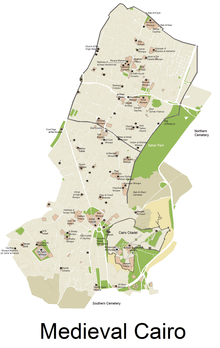Bab al-Futuh
Bab al Futuh (Conquest Gate) is one of three remaining gates in the walls of the old city of Cairo, Egypt. It was finished in the year 1087 and faces north. The other two remaining gates are Bab al-Nasr (Victory Gate) in the north and Bab Zuwayla (Gate of Zuwayla) in the south.[1] Bab al-Zuwayla and Bab al-Futuh are located on Muizz Street in Cairo.[2]
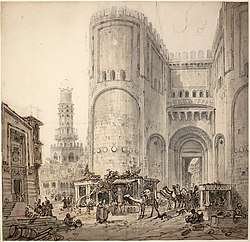
The gate was part of fortification built by Vizier Badr al-Jamali of Fatimid Imam/caliph Mustansir. Its rounded towers were a stronger defense than the square towers of Bab al-Nasr (another Old City gate, just to the east). They had shafts for pouring boiling water or burning oil on attackers, and arrow slits. The gate is covered in vegetal and geometric motifs.
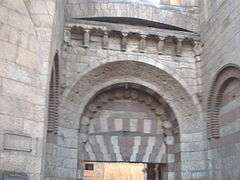 Bab al-Futuh, Cairo
Bab al-Futuh, Cairo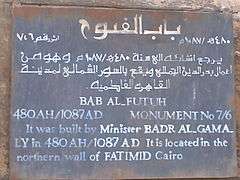 Name plate
Name plate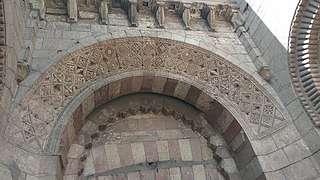 Stone carving designs
Stone carving designs- Bab al-Futuh, Cairo
 The outer rounded tower of Bab al-Futuh
The outer rounded tower of Bab al-Futuh
Architecture
The height of Bab al-Futuh is 72.1785 ft (22 m) with a width of 75.4593 ft (23 m).[3] Syrian stone was used to create the gate.[4] The purpose of this gate was to prevent attacks from happening. As a result, this fortification was built. It consists of two tall towers that are connected together by a wall.[5] Below the wall is the entrance.[5] The wall above the entrance contains Islamic architectural elements such as a semicircular arch with stone carved designs and triangular pendentives.[5] In addition, it includes Not only does this gate contain Islamic architectural elements, but it also contains military architecture. The two tall towers are rounded in shape.[6] This allowed people to stand on the two towers pouring hot water or hot oil, and launching arrows towards enemies.
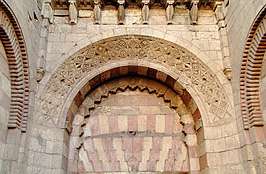
References
- Rabbat, Nasser. The Citadel of Cairo: A New Interpretation of Royal Mameluk Architecture. Leiden ; New York ; Köln Brill. p. 13.
- Tignor, Robert L. (2010). Egypt: A Short History. Princeton University Press. p. 146.
- Torky, Tarek (2019). "Discover Islamic Art Bab al-Futuh". Museum with No Frontiers.
- "Bab al-Nasr". Archnet. Retrieved 2019-12-09.
- "Bab al-Futuh". Archnet. Retrieved 2019-12-09.
- "Bab Zuwayla". Archnet. Retrieved 2019-12-09.
